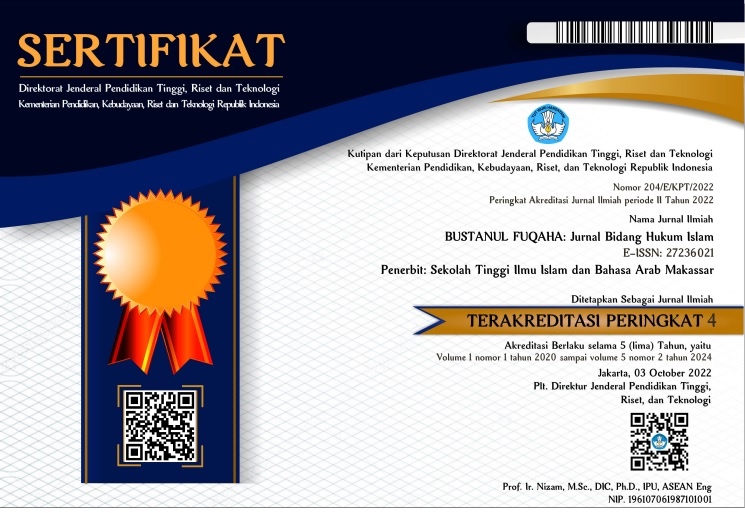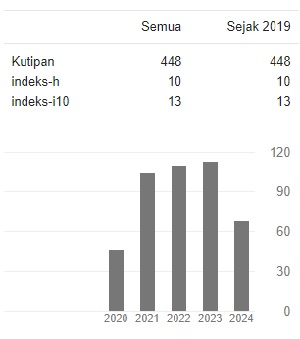Konsep Keluarga Sakinah dalam Al-Qur’an dan Implementasinya dalam Kehidupan Rumah Tangga
The Concept of the Sakinah Family in the Qur'an and Implementation in Life Household
DOI:
https://doi.org/10.36701/bustanul.v3i1.523Keywords:
family, sakinah, Al-Qur'an, implementation, householdAbstract
The research to identify and understand the concept of the sakinah family in the Qur'an and its implementation in domestic life. The problems that have been raised in this study are: First, what are the tips that must be done to create a sakinah family. Second, what is the view of Islamic law regarding the concept of the sakinah family and its implementation in domestic life. Third, the views of scholars on the interpretation of surah ar-rm: 21. To get answers to the problems above, the author uses a qualitative descriptive research type, which focuses on the study of manuscripts and texts, using a historical-factual approach. The results of the study were found as follows: First, how to create a sakinah life. The tips that must be done are choosing the right wife or husband, educating the wife, making the household a place of remembrance of Allah swt., making the house a place of worship, paying attention to the prescribed prayers and sunnah actions related to the house, making it a habit to read surah al-Baqarah at home to exorcise the devil, teach the family, run. Second, then the view of Islamic law regarding the concept of the sakinah family and its implementation in family life is a very ideal family condition that is formed based on the Qur'an and sunnah to achieve happiness in the world and in the hereafter. This is explained in the Qur'an surah al-Rūm: 21. In this case it is necessary how a married couple must pay attention to the obligations that must be carried out fully.
Downloads
References
-------------------------. Riyadhu al-Shalihin Bab Washiyah bi al-Nisaa’. Cet, II; Dar al-Fikr, 1421 H.
------------------------. Syarhu Hadis Ibnu Umar. t.tp: Dar al-Fikr, 2021.
Al-Bukhari, Muhammad bin Ismail. Ṣahih Bukhari, t.tp.: Dār Ibnu Al-Kaṡīr.
Al-Mawardi , Ali Bin Muhammad. Nukat Wa Al-‘Uyun Tafsir Al-Mawardi. Cet. III; Lebanon: Dar al-Kutub Al-‘Ilmiyyah. 1992 .
Al-Qasairi, Muslim bin Al-Hajaaj. Shahih Muslim Kitab Shifatu al-Qiyamah wa al-Naar Baab Tahrisy al-Syaithan wa Ba’tsihi Sarayahu Lifitnati al-Nas. t.tp: Dar al-Kutub al-Ilmiyah Bairut, t.th.
Al-Qur’an dan Terjemahannya. 2014. Bandung: Kementrian Agama RI
Al-Sa'di , Abdurrahman bin Nasir. Tafsīr Al-Sa’di. Cet III; Jakarta: Pustaka Darul Baq. 2016.
Al-Utsaimin, Muhammad bin Shalih. Syarhu Hadis Ibn Mas’ud Bulughu al-Maram Kitabu al-Nikah. t.tp.: Dar al-‘Ilmiyah, t.th.
Dewi, Nyoman Riana dan Hilda Sudhana. Hubungan Antara Komunikasi Interpersonal Pasutri dengan Keharmonisan dalam Pernikahan: “Jurnal Psikologi Udayana 1, no. 1 (2001).
Husna, Cut Asmaul. Tantangan dan Konsep Keluarga Sakinah Mawaddah Wa Rahmah di Era Millenial Ditinjau dari Perspektif Hukum Keluarga. Jurnal Lus Civile 3 no. 2 (Okt 2019).
Ibad, Ukasyah. Suami Shalih Dambaan Istri. Cet. I; Surakarta: Gazza Media, 2011.
Ibrāhīm , Abdullāh. Nasihat dan Pelajaran Calon Pengantin. Cet.I; Surabaya: PT. ELBA Fitrah Mandiri Sejahtera, 2005.
Katsir, ibnu. Tafsīr Ibnu Kaṣīr. Cet. III; Dar Al-‘Ilmiyah. 774 H. Kitabu al-Nikah. t.tp.: Dar al-‘Ilmiyah, t.th.
Mahmud, Shihabuddin al-Sayyid. Ruh al-Ma'ani fi Tafsir al-Qur'an al-'Azim wa al-Sab'i al-Mutsani. t.tp: Dar al Fikr, 1994.
Miswanto, Agus. Keluarga Sakinah dalam Perspektif Ulama Tafsir. Cakrawala: Jurnal Studi Islam 14 no 2 (2019).
Noorhayat, Mahmudah. Konsep Qona’ah dalam Mewujudkan Keluarga Sakinah Mawaddah dan Rahmah. Jurnal Bimbingan Konseling Islam 2 no. 2 (2007).














